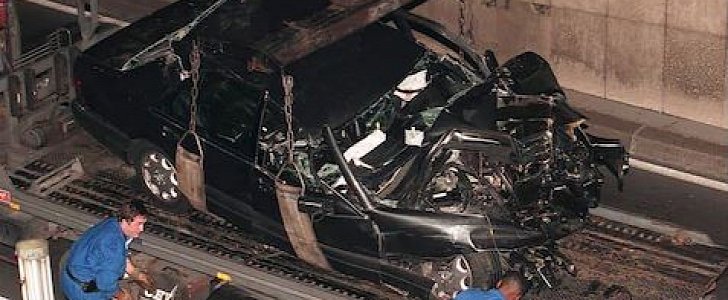On August 31, 1997, the Princess of Wales was killed in a one-vehicle crash in an S-Class in Paris, together with her boyfriend Dodi Fayed and her driver Henry Paul. Her bodyguard survived, because he was the only one who was wearing a seatbelt at the time of the impact.
Had Diana wore hers as well, she would probably still be alive, UK’s top forensic pathologist Dr. Richard Shepherd says in a new book, excerpts of which have been published by the Daily Mail in its Sunday column. Dr. Shepherd was asked to review the evidence and testify in the 2004 inquest that ruled out that the crash was an accident, and not some kind of attack.
His conclusion: Diana died from a very rare and very tiny injury, the kind of which he’s only seen once. On her.
“She actually suffered just a few broken bones and a small chest injury – but this included a tiny tear in a vein in one of her lungs,” Dr. Shepherd says. “Diana’s was a very small injury – but in the wrong place. Diana’s death is a classic example of the way we say, after almost every death: if only. If only she had hit the seat in front at a slightly different angle. If only she had been thrown forward 10mph more slowly.”
When first responders arrived on the scene, Diana was still alive and able to communicate with them, which translated into some delay in getting her in an ambulance. This made matters worse, because the longer she waited, the more the vein bled. On the ride to the hospital, she started losing consciousness and eventually went into cardiac arrest.
Doctors determined the cause when she was at the hospital, and proceeded to operate on her but, by that time, it was too late.
However, Dr. Shepherd says, the “biggest if only was within her own control.” “If only she had been wearing a seat belt. Had she been restrained, she would probably have appeared in public two days later with a black eye, perhaps a bit breathless from the fractured ribs and with a broken arm in a sling,” the expert concludes.
Dr. Shepherd notes that Diana’s bodyguard survived because he secured the seatlbelt at the last moment. This also helped Diana initially survive the crash, as his seatbelt absorbed some of the force with which she was propelled forward against the seat, since she was seated right behind him.
His conclusion: Diana died from a very rare and very tiny injury, the kind of which he’s only seen once. On her.
“She actually suffered just a few broken bones and a small chest injury – but this included a tiny tear in a vein in one of her lungs,” Dr. Shepherd says. “Diana’s was a very small injury – but in the wrong place. Diana’s death is a classic example of the way we say, after almost every death: if only. If only she had hit the seat in front at a slightly different angle. If only she had been thrown forward 10mph more slowly.”
When first responders arrived on the scene, Diana was still alive and able to communicate with them, which translated into some delay in getting her in an ambulance. This made matters worse, because the longer she waited, the more the vein bled. On the ride to the hospital, she started losing consciousness and eventually went into cardiac arrest.
Doctors determined the cause when she was at the hospital, and proceeded to operate on her but, by that time, it was too late.
However, Dr. Shepherd says, the “biggest if only was within her own control.” “If only she had been wearing a seat belt. Had she been restrained, she would probably have appeared in public two days later with a black eye, perhaps a bit breathless from the fractured ribs and with a broken arm in a sling,” the expert concludes.
Dr. Shepherd notes that Diana’s bodyguard survived because he secured the seatlbelt at the last moment. This also helped Diana initially survive the crash, as his seatbelt absorbed some of the force with which she was propelled forward against the seat, since she was seated right behind him.
















